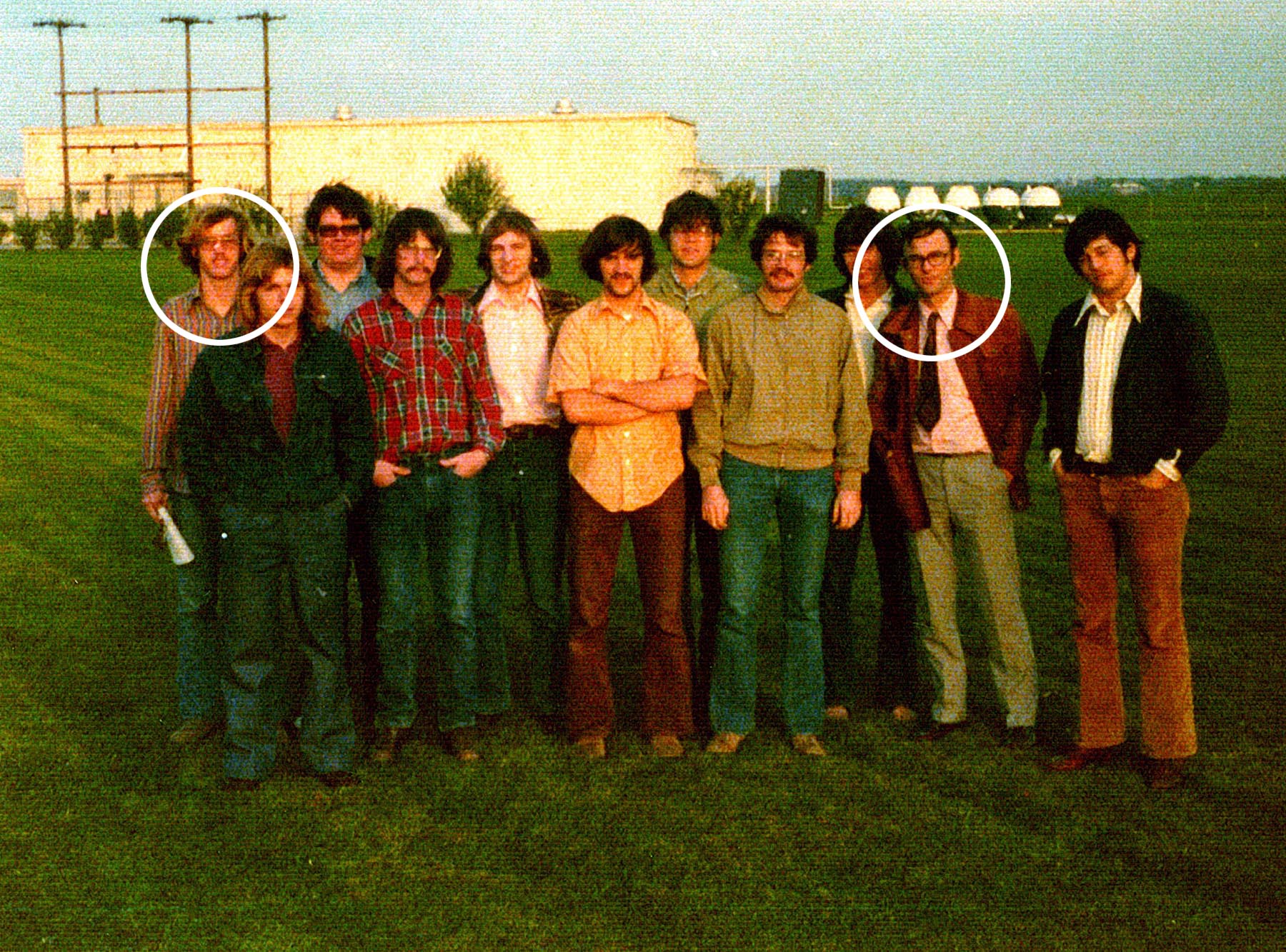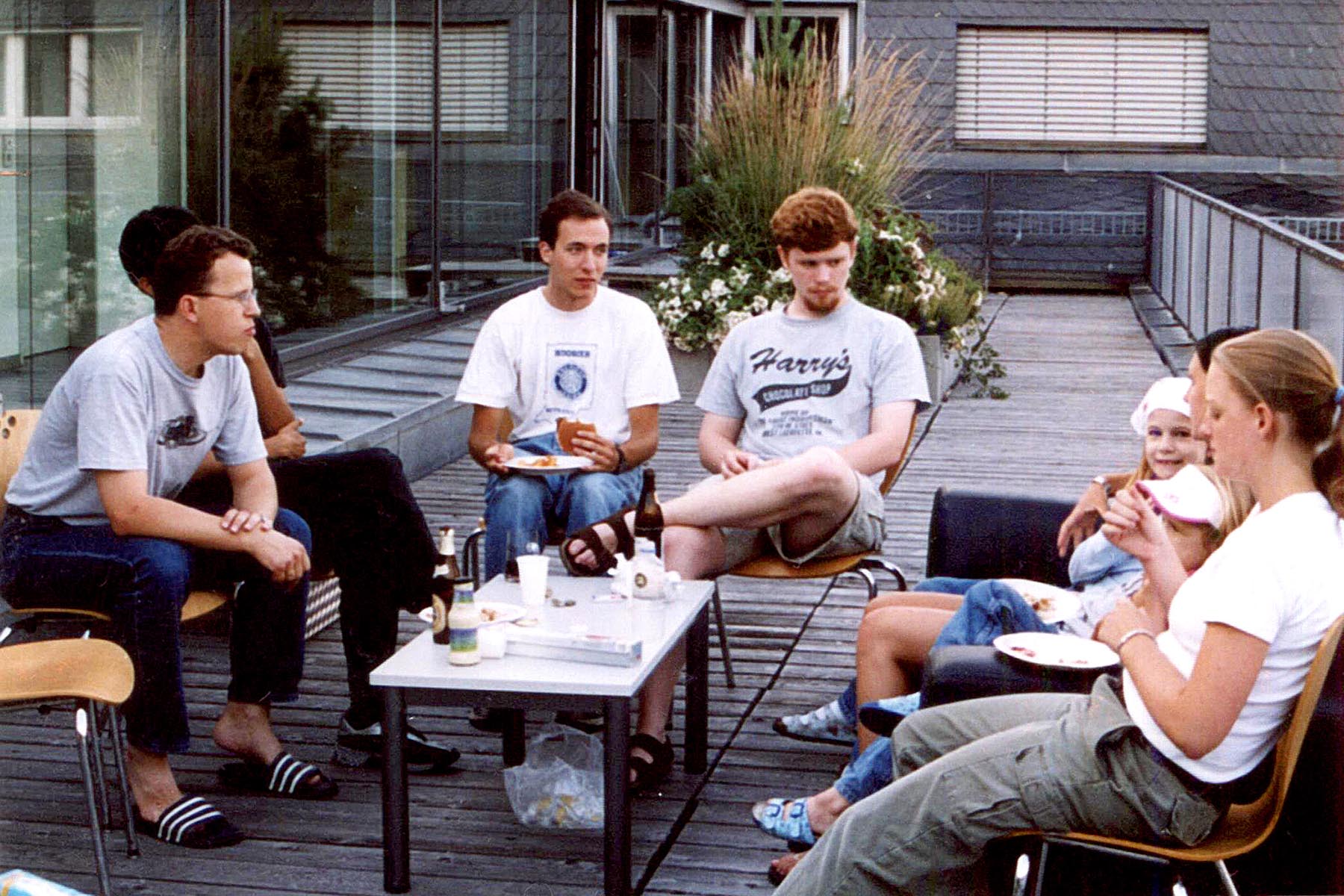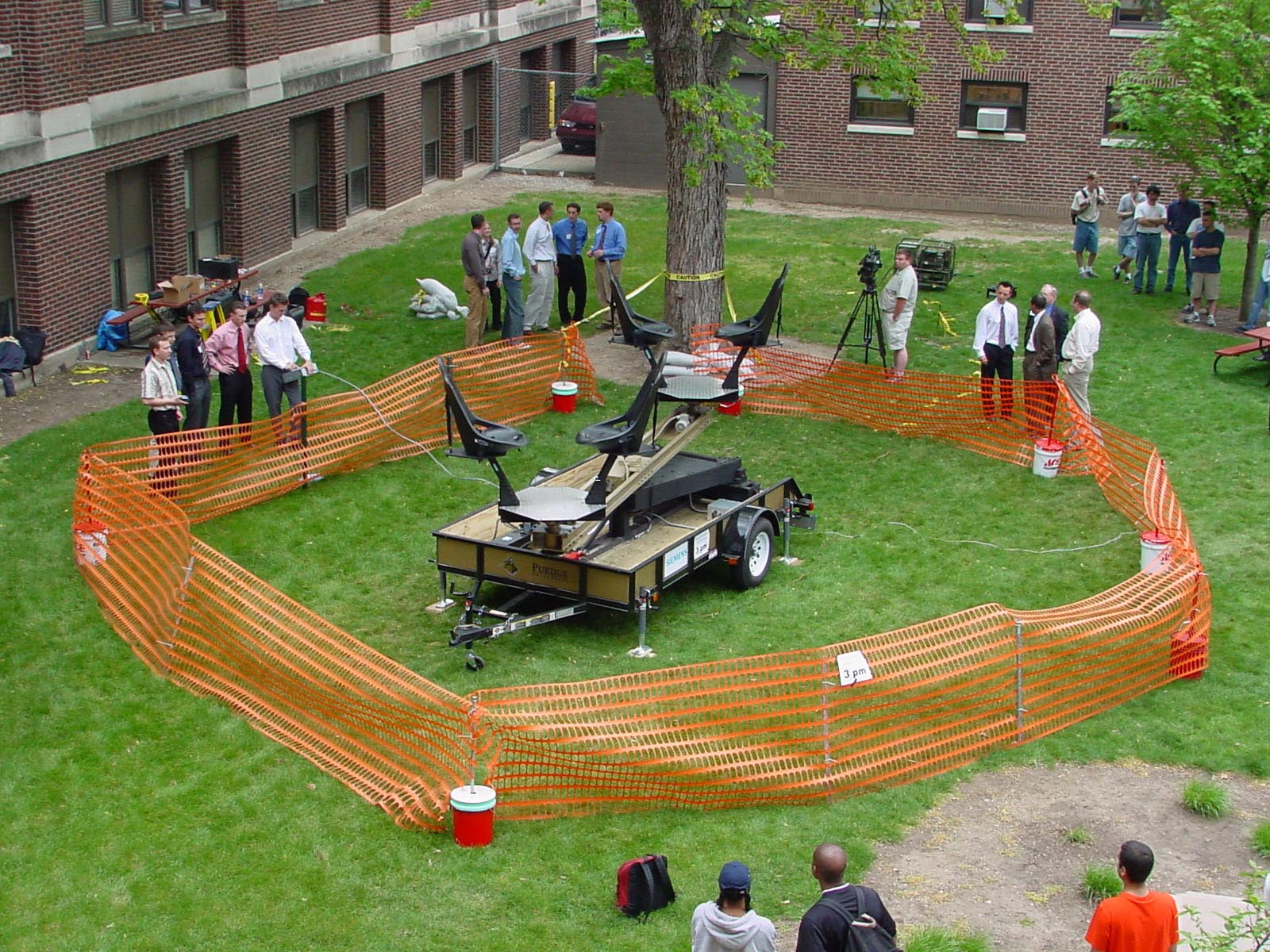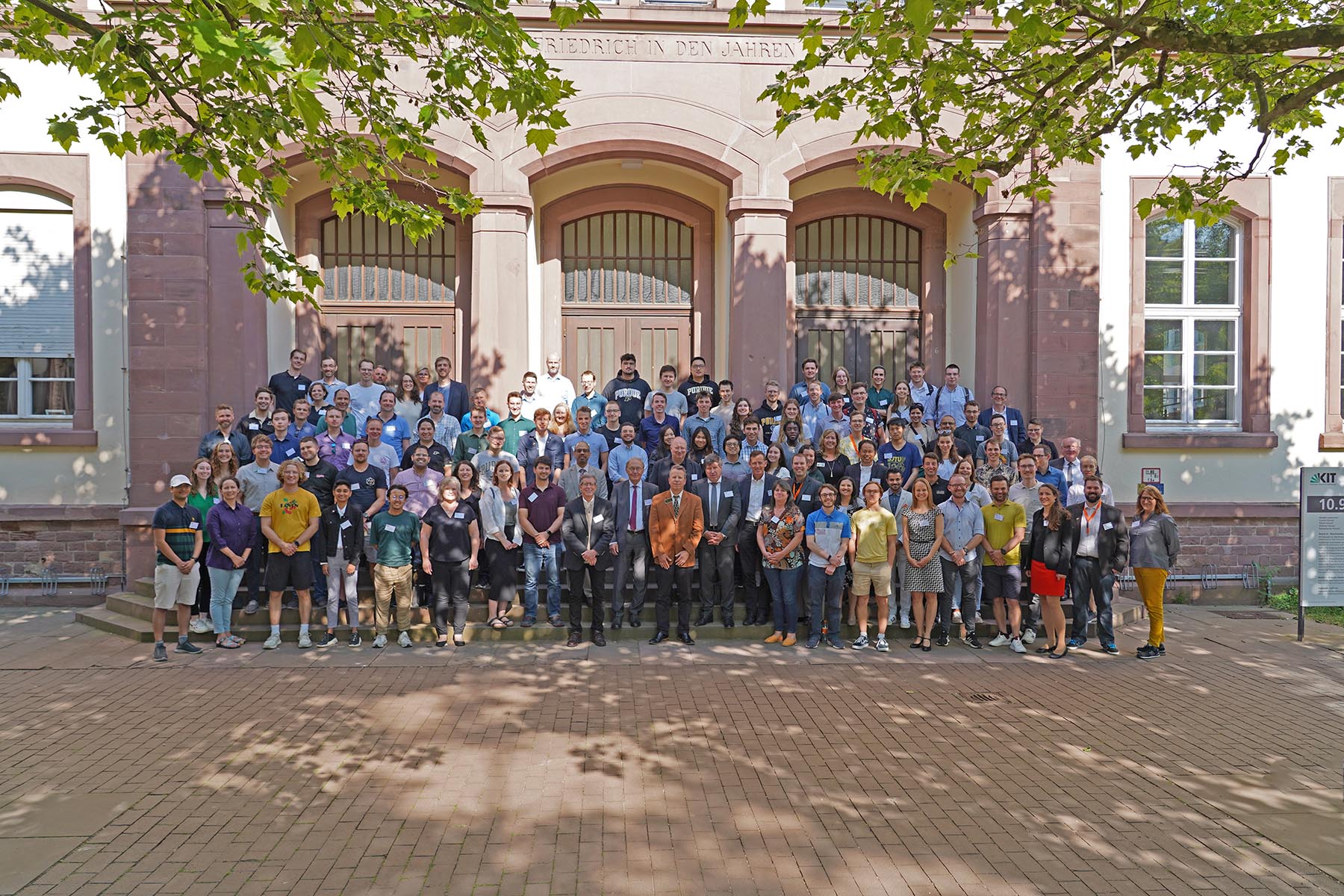Getting in GEARE: Purdue's premier study abroad program celebrates its 20th anniversary
In May 2023, many of these students and professors returned to Karlsruhe for a 20th anniversary reunion: sharing stories about renegade carousels, Formula 1 road trips, and how the percentage of Purdue ME students studying abroad increased from 1% to 40%.
Humble Beginnings
Karlsruhe is home to 300,000 people, nestled at the edge of the Black Forest near Germany’s southern border with France. In addition to serving as the seat of Germany’s legal system, it also hosts a beautiful palace at the center of town, an underground transit network, a zoo, a soccer stadium, multiple theaters, and one of the most prestigious engineering schools in Germany: the Karlsruhe Institute of Technology (KIT), founded in 1825.
And every spring in Karlsruhe, you’ll see something you might not expect: students wearing Purdue hats and T-shirts.
In 2003, Karlsruhe became the jumping-off point for GEARE, Purdue University’s Global Engineering Alliance for Research and Education. For the last two decades, GEARE students have gone beyond just studying abroad: they also undertake an international work experience, participate in cultural training, and team up with international students to complete a collaborative global design team project. It’s the ultimate opportunity for Purdue students to become “global engineers,” in an industry where international experience is more important than ever.
But these grand visions of international cooperation had humble beginnings.
It all started with a young student named Dan Hirleman, trying to navigate his undergraduate years at Purdue in the early 1970s. After deciding to pursue mechanical engineering, he had a unique encounter after a Thermodynamics class. “The professor was this guy named Sigmar Wittig, visiting from Germany,” remembered Hirleman. “He asked me, ‘How would you like to do some research?’ And I said, ‘Sure, what’s research?’ And Professor Wittig said, ‘We’re studying kinetics in a shock tube.’ And I said, ‘What’s a shock tube?’ Obviously I had a lot to learn!”

“I recognized him as the most outstanding student in the class,” said Wittig, who taught at Purdue from 1967 to 1976. “I knew he was capable of doing more. In Germany, undergraduate students contribute to research very early in their careers. So Dan worked with me for three semesters at Zucrow Labs. Eventually we published research together, and even presented at a shock tube conference in Japan.”
Hirleman and Wittig stayed in touch as they progressed through their respective careers. By the late 1990s, Dan Hirleman had become head of the School of Mechanical Engineering at Purdue, while Sigmar Wittig had become President of the University of Karlsruhe (later renamed the Karlsruhe Institute of Technology (KIT)). In his pitch to become head, Dan had emphasized the imperative of increasing the global awareness of Purdue engineering students – and with the help of his friend Sigmar Wittig, Karlsruhe was the perfect partner.
“When I started as head of Purdue ME, we had about 1,200 students – but only three students total had studied abroad that year. That’s less than one percent!” said Hirleman. “We asked students why, and they said three things: it’s too expensive, it will delay their graduation, and they were afraid they couldn’t make friends because they didn’t speak the language. We designed GEARE as a solution to those problems.”
Step one was assuring GEARE students that they could take Purdue core classes overseas, allowing them to stay on track and graduate on time. Doing so required navigating the mammoth academic bureaucracies of two institutions on two separate continents. Hirleman accomplished this with a team of people – Dianne Atkinson, Jerry Matthews, and especially associate professor Eckhard Groll.
“I myself am a product of study abroad,” said Groll, who is now the head of the School of Mechanical Engineering at Purdue. “I attended Ruhr University Bochum in Germany, and first came to the United States as part of an exchange program. It was a life-changing experience for me. So because I knew the academic systems of both the US and Germany, I could translate the syllabi and convince Purdue to accept the equivalent courses from KIT.”

They also wanted the experience to be cost-neutral for students, requiring no more funds for Karlsruhe than for West Lafayette, or any other future global destination. That’s where Purdue alumnus Tom Malott (BSME '62) stepped in. Having advanced to become president and CEO of Siemens Energy and Automation, he established a GEARE endowment with his wife, Sandra. “I really believed in the vision,” said Malott. “Dan Hirleman had put together something unique: a combination of academics, global experience, and industrial experience. In my work with Siemens, I learned that understanding the values and culture of a people is just as important as solving physical problems. You can be the best engineer in the world, but it won’t do you a damn bit of good if you don’t first learn about their culture and build up those relationships.”
The final piece of the puzzle, collaboration with industry, was Sigmar Wittig’s suggestion. “German students are required to have industrial experience – usually spending half a year in apprenticeship with a company,” he said. “Dan and I knew that corporate support was vital to this educational experience. So we arranged for students to do an internship at Siemens, Cummins, or John Deere in the US; and another internship here in Germany, ideally with the same company.”
As part of the preparation for GEARE, students would also take 12 credit hours of language classes before leaving for Germany. “This was important for forming community,” said Hirleman. “Even though the core classes are taught in English, you need to be able to speak to locals, make your way around town, and truly participate in the culture to have a proper global experience.”
The First Cohort
By 2003, Hirleman and his team had successfully convinced the administrations of Purdue, KIT, and international companies to join in this new GEARE collaboration. Now all they needed were students. “Our students at Purdue saw the value of GEARE pretty quickly,” said Hirleman. “But some of their parents needed convincing that a lab in Karlsruhe is just as effective as a lab in West Lafayette. In the end, we took six students to Germany that first year.”
They also needed boots on the ground – people who could travel to Germany and actually deliver the promised experience. Eckhard Groll stepped up. Taking a sabbatical from Purdue, he moved his family to Karlsruhe for the year, living in the same international housing complex as the six GEARE students. “I sort of became a bridge for them between the US and Germany,” said Groll, “and they became big brothers and big sisters to my two young daughters. We took trips, celebrated birthdays, and even had an American-style barbecue on the Fourth of July. We became very close, and I really admired them for being trailblazers in this program.”

The first GEARE cohort also included nine KIT students, who were embarking on a parallel program to eventually study in the United States. They had their own champions: KIT professors Albert Albers and Norbert Burkardt. “I had already been teaching mechanical design classes in English for our international students at KIT,” said Burkardt. “When I learned about Purdue and GEARE, I thought the idea was great. This was a new thing for all of us, so we did a lot of learning together. These Purdue students jumped into a pool of cold water, and had to learn to swim!”
Round and Round
Beyond the classes and the internships, the final aspect of GEARE involved a global design team project, where both Purdue and KIT students would collaborate on designing a novel and essential product.
So they chose... a carousel?
“I can’t remember whose idea it was,” said Burkardt. “I know if you had a child’s birthday party, the parents could rent one of these rides, and we wondered if we could design one of these from scratch. It was a crazy idea!”

“This came from Albert Albers, who taught product design at KIT,” said Groll. “They have a year-to-year sequence of design courses, just like Purdue. And in 2003, all KIT students were given the same challenge: to design a carousel. So our Purdue students jumped right in. Three different groups designed three different carousels, presenting them at the end of the semester, and one of the US designs was judged the winner! But it was all on paper; we never actually built anything in Germany.”
Fast forward to the next year, when the GEARE and KIT students returned to Purdue. They decided they wanted to bring their carousel idea to life. “We’re engineers, so we used an evaluation matrix to decide which design to build,” said Groll. “It had to fit on a trailer to be transportable, and it had to fit within a budget given to us by Dan Hirleman. Thankfully, we had lots of parts donated from Siemens and other companies. We machined the parts and assembled everything at Herrick Labs.”
The final design consisted of a steel I-beam on a hydraulic lift, with rotating two-seat platforms on both ends. The I-beam spun around, and the individual two-seat platforms also rotated. The entire ride could fold down to fit into a flatbed trailer, which could easily be set up in the backyard for a child’s birthday party.
If you think it sounds dangerous – a spinning thrill ride made out of spare parts, designed by 20-year-olds who speak different languages – you’re not alone. “Purdue Safety would not let us operate it with people,” said Groll. “We parked it in front of the ME Building, and they put up orange construction fencing all around it. They would only allow us to put sandbags in the seats to simulate the load of people actually riding it. But it worked beautifully.”
The students would not be deterred. They convinced Groll to haul the trailer to the backyard of his own home, away from the prying eyes of Purdue Safety. “Then we all rode it,” laughed Groll. “The students rode it, my daughters and I rode it. Even Professor Albers rode it when he came to visit from Germany, and he was so impressed. It was definitely the most memorable design project I’ve ever been involved in!”
The carousel even attracted TV news reporters from Indianapolis. “That was when I knew GEARE was a success,” said Hirleman. “I remember one of the German students telling the reporter: ‘If this were just a German project, we’d still be modeling and we never would have built it. If this were just an American project, they would have built ten prototypes that didn’t work. But working together, we developed a real product!’”
Going Farther
Since that first cohort, nearly 1,000 Purdue students have participated in GEARE. Shanghai Jiao Tong University in China came on board alongside Purdue and KIT, enabling student exchanges between three continents. More destinations were added: France, Switzerland, Spain, Mexico, Brazil, Colombia, Ecuador, South Korea. GEARE students earn a Global Engineering Studies minor, giving them a clear advantage when competing for engineering jobs in the 21st century.
One of those students was Francisco Montalvo, who first came to Purdue from Ecuador in 2003. Within a few months on campus, he began to get antsy. “I was doing a co-op with the Bosch Group in Fort Wayne, but at that age, I really wanted to see more of the world,” said Montalvo. “The director of the co-op program happened to be Eckhard Groll, who told me about GEARE and the opportunity to travel to Germany. When I asked my parents about it they said, ‘You’re already studying abroad! Why would you want to go farther?’ Eventually they came around to see the value in the program. Everyone was so supportive: my parents, the faculty, everyone here at Purdue helping me do this crazy thing of doing both a co-op and traveling overseas!”
When Montalvo’s cohort of six students first landed in Germany in 2007, they immediately learned a cultural lesson – but not one they were expecting. “At Frankfurt Airport, our first task was buying train tickets to Karlsruhe,” he remembers. “For some reason they pushed me to the front of the line, and I started to ask questions in German. As it turns out, the guy behind the counter spoke Spanish! It certainly shattered my stereotypes about Germany. That was our first lesson in how interconnected all the different countries in Europe are.”
Their housing complex included students from all over the world – including Chinese GEARE students splitting their time between Shanghai and Karlsruhe. “We were right in the middle of town, so we made friends everywhere,” said Montalvo. “It was summer, so the sun stayed up late into the night. As long as we could figure out which tram would take us home, we were fine!”
While their engineering classes at KIT were in English, there was still a lot to learn about German academic culture. “The learning style in Germany is very different,” Montalvo said. “The students there have much more independence. They rarely have graded quizzes or homework; the only grade is the final. So you could skip lectures if you wanted, but you would pay for it at the end! Thankfully, we had a counterpart cohort of six KIT students who were fantastic, and helped to guide us through this process.”
The Purdue cohort also benefited from the well-natured ribbing of Norbert Burkardt. “He was such a great instructor,” said Montalvo. “He would diagram machine components, and then joke, ‘And for you Americans in the back, this is a clutch!’ He was amazed that most Americans couldn’t drive a stick-shift car!”
Indeed, Montalvo was the only member of the Purdue cohort who could drive a manual transmission – which means he was pressed into service when they decided on a spur-of-the-moment road trip to Spain. “Typical of 20-year-olds, there was very little planning involved,” laughs Montalvo. “But as we drove through France, it happened to be the weekend of the Monaco Formula 1 race! We camped at this horrible French campground, and lucked into cheap tickets to actually watch the race! Being in the heart of Europe was just amazing.”
Montalvo’s German internship, at Siemens Professional Education in Berlin, had an even more direct impact on his life. After graduation, he returned to Germany and worked at Siemens for four years, which inspired him to become an educator himself. “It was completely transformational,” he said. “It showed me that I could have a career in engineering education. Fast forward to today, and here I am, back at Purdue as a lecturer in Mechanical Engineering! It can all be traced back to my GEARE internship.”

Welcome Back
When Purdue and KIT announced a 20th anniversary reunion event, Montalvo wasn’t the only one excited to go – his entire 2007 cohort returned to Karlsruhe. “It was incredible to go back and see old friends,” he said. “But it was also incredible to see where the program has gone since then. There were alumni there from every generation, all in one place. It was amazing to see how much GEARE had impacted everyone’s life.”
Purdue and KIT professors rubbed shoulders with many of their former students, who are now involved in influential industry or government positions; some even becoming professors themselves. Through barbecues, get-togethers, and hikes through the Black Forest, they were able to share their experiences of how this international experience changed their lives. “If you look around at the room today, you see that everyone there is extremely successful in whatever they do,” said Eckhard Groll. “GEARE helped to set them on that trajectory. This is why many of us got into education: to help students get on their future path to success. It’s hard to describe how that makes me feel. It’s truly special.”
Sixteen years later, Montalvo’s cohort picked up right where they left off. They found their 2007 design project, an omnidirectional robot base, still operating in a KIT campus lab. They even rented electric scooters and zoomed around Karlsruhe late into the night. “Even though we now have wives and kids, we still found time to storm the castle!” laughs Montalvo.

Shortly after GEARE began, Sigmar Wittig left KIT to become chairman of the board of DLR (the German equivalent to NASA). But he was thrilled to return for the reunion, and see that his collaboration with Purdue is in good hands for the future. “I have seen many programs come and go at the university level, and there are not many that have lasted as long as GEARE,” he said. “I personally saw how enthusiastic the American students were. When you look into their eyes, you see that they are ambassadors for the future.”
Norbert Burkardt is also retired from KIT, but happily returned to campus to join his former students in reminiscing about GEARE. “Sometimes I discuss global engineering challenges with colleagues at other universities,” he said. “Talking is one thing – but with GEARE, we are actually doing it! It’s been a great benefit to know that I’m a part of it.”
Perhaps no one was more gratified to see this reunion of GEARE alumni than Dan Hirleman, who is now Purdue’s Executive Director for International Advancement. Remember 2003, when less than 1% of Purdue mechanical engineering students studied abroad? Today, it’s almost 40%. “You see 20-year-olds go through this experience and they realize – for the rest of their life, they are going to look at problems differently than the rest of their teammates,” said Hirleman. “That was the goal. Seeing the success of all these students, it’s very gratifying. Of all my accomplishments, GEARE is definitely up there on the medal stand.”
Joe Tort, Purdue’s Associate Director of Global Professional Practice who helped to organize the reunion event, sees bright things for GEARE’s future. “We have put a premium on global competency development,” he said, “and we know that GEARE students make tremendous strides in their abilities to understand difference, communicate effectively across cultures, and lead diverse teams. We are looking forward to the next 20 years of GEARE where we will increase study abroad and internship opportunities around the world.”
“GEARE is the most complete way you can experience global engineering,” said Francisco Montalvo. “You not only get study abroad experience, which is valuable in itself, but you also get a work abroad experience, which is still very rare in the United States. You get very robust intercultural training, including language training. By the time you graduate, you have experience that even people already working in industry don’t have. Job placement for GEARE students is almost 100%. And all of this within your normal tuition at Purdue! It’s incredible.”
Eckhard Groll agrees: “Now more than ever, global programs are key,” he said. “The challenges we’re facing – climate change, food security, clean water, transportation, communications, medical issues – all of these are global challenges. There’s no program I know that can do this better than GEARE.”

Writer: Jared Pike, jaredpike@purdue.edu, 765-496-0374
GEARE websites: purdueGEARE.org, engineering.purdue.edu/ME/GEARE
